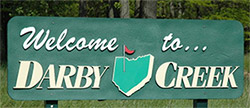 To get to Darby Creek, you drive through a few towns the likes of which you’ll be surprised still exist. You’ll hang a right at a driving range in the middle of nowhere, drive another few miles, then take another right. A golf course appears, and suddenly you’ve arrived at Darby Creek.
To get to Darby Creek, you drive through a few towns the likes of which you’ll be surprised still exist. You’ll hang a right at a driving range in the middle of nowhere, drive another few miles, then take another right. A golf course appears, and suddenly you’ve arrived at Darby Creek.
The course takes its name from a stream which is two miles from the course itself. Designed in 1993 by the design tandem of Brian Silva and Geoff Cornish, Darby Creek blends a bit of the old and a bit of the new, just like the designers themselves (Silva graduated from college in 1973, Cornish was born in 1914).
Conditions
The midwest is a great place for farming, and similarly, a great place to build golf courses. The fertile soil doesn’t contain nearly as much clay as courses further east. Though the weather only permits for a six- or seven-month golf season, the conditions during those six months are often rather good for a golf course.
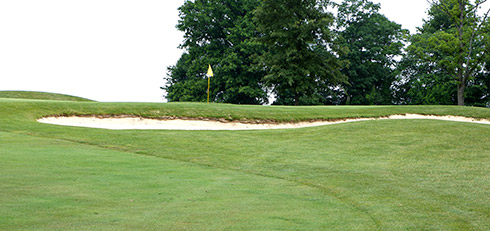
The 17th green – a downhill and then uphill, sometimes reachable par five with a moderately sloped green – is usually dead into the wind.
Darby Creek is situated in the gently rolling hills just northwest of Columbus, OH, and on what appears to be old farmland (or at least very near to existing farmland). It benefits from the rich soil, reasonable weather, and gentle terrain this area provides to provide a golf course that’s in good but not great shape.
The greens and tees were exceptionally well maintained. At nearly 15 years of age, the course’s greens have matured wonderfully. The greens grass is healthy, the thatch layer is low, and shots hold, skip, or bounce appropriately. Putts rolled smoothly and with a good pace, and pitch and chip shots reacted properly as well.
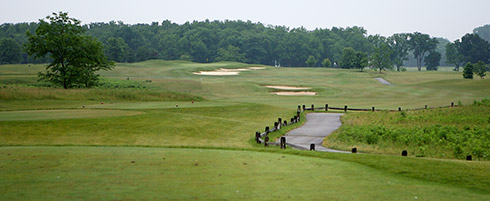
The enjoyable par-five sixth. Your tee shot should be just right of two large fairway bunkers, then you’ve got to decide between a narrow fairway left of the massive bunkers further ahead and a wider fairway to the right with a less desirable angle for your approach.
Things get just a teeny bit rougher in the fairways and rough. The fairways were rather firm and I came upon several shots that sat upon what I’d call “grassy hardpan.” The rough had a few patches of similarly hard ground. I have no complaints whatsoever about the quality of the grass, and must say that with just a little more water or a more regular schedule, the hardpan problems could have been eliminated.
Bunkers are maintained adequately, though not exceptionally. Greenside bunkers seem to feature a significant amount of sand, leading my playing partners to fluff their bunker shots and leave their balls in the bunkers. Such deep sand makes it difficult to play from and difficult to rake evenly. Fairway bunkers rightly feature much less sand and are quite good.
Finally, Darby Creek features some tall fescue type grasses, and these areas were not only beautiful but well kept up. Of course, the trick to these types of areas is to not maintain them at all, and the greenskeepers at Darby Creek have done a good job of non-maintenance where it’s best. Kudos to them for knowing when to leave nature to its own and not to over-help.
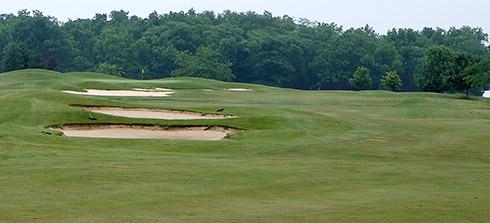
Another look at the sixth. The bunkers are all in a line, but the optimal play is right of the first set and left of the second.
Lest you get the wrong idea, Darby Creek is well above the average in terms of conditions and maintenance. With a little less grassy hardpan and a little less greenside sand, it could be truly exceptional.
Design and Layout
Darby Creek’s nines are divided into two “themes” – the front nine is known as the “Links” nine and the back the “Woods” side. The “Links” side aspires to be a Scottish “links” type course while the back aims to be more of a traditional American routing through the trees.
Though it’s just a name, I find the practice of calling anything inland – much less inland Ohio – a “links” layout. Darby Creek isn’t even near its namesake let alone a lake or ocean. Furthermore, the “Woods” nine has quite a few holes that are more in the style of the other nine, making the naming of each nine even more ludicrous. I have no problem with saying “here’s a golf course” and leaving it at that, and wish the folks at Darby Creek would have chosen that route.
With the exception of the 11th hole, the par threes are pretty standard fare. The third plays 189/169 from the two tees and favors a draw, as the green slants back and to the left. The seventh plays 172/144 and slants the other direction. The 16th is the longest, but is a rather plain uphill affair of 211/188 yards.
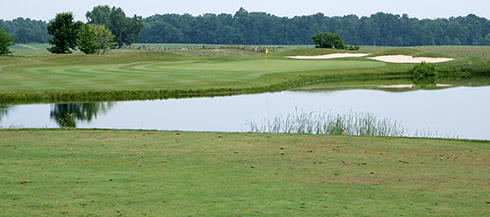
The water shouldn’t really come into play at the 11th except for a back-right hole location. Maybe.
The 11th at 194/168 yards stands out. It’s the one par three on the course which features water, even if it really doesn’t (or shouldn’t!) come into play. The green, like the seventh, is angled back and to the right, favoring a cut. The green contours towards the water, which is well in front and closer to the right side. A bail-out area exists short and left, but long and right two bunkers will snatch up your ball.
The par threes do stand out in one way, and that is that they each ask for a certain shot. With the exception of the 16th, the way the greens are angled to the line of play really helps to enforce either a draw or a cut. Into the 11th, for example, you can hit anything from a hard 7-iron to a low running cut with a 4-iron (from the “Back” tees, one up from the “Championship” tees) that utilizes the slope to feed the ball to the hole.

The fifth green. It’s a short hole, but the fairway bunkers are not the place to be. Hit any club from the tee, but hit it straight or draw it.
The par fives are varied. The Links side features two you likely won’t get to in two: the fourth at 558 yards and the sixth at 520 and uphill. The sixth features a lovely split fairway in the landing area of the second shot with bunkers forming the divide. The fairway to the left is narrower, but provides an ideal angle to approach virtually every hole location on the green. The second features a bland, blind tee shot up and over a hill, but a well-bunkered green with only a narrow chute through which to run up an approach.
The par fives on the back nine are both a little more bizarre and a little more reachable. The 14th measures only 502 yards, but has a gully about 280 yards from the tee (and a bunker on the right side at 255). I reached the hole with a bunted driver and a hybrid, but the second shot had to carry two or three massive bunkers in front of the green. The layup, if you opt to do so, isn’t easy either, as you can lay up short or right. Either position could be ideal depending on your strengths and the pin position. Holes like this are a joy to play, as they really allow for different strategies. You can hit three irons (say, 4-iron, 4-iron, pitching wedge) or you can risk running your driver towards the end of the fairway (and that bunker) and risk carrying the greenside bunkers, uphill 40 feet or more, in going for the green in two.
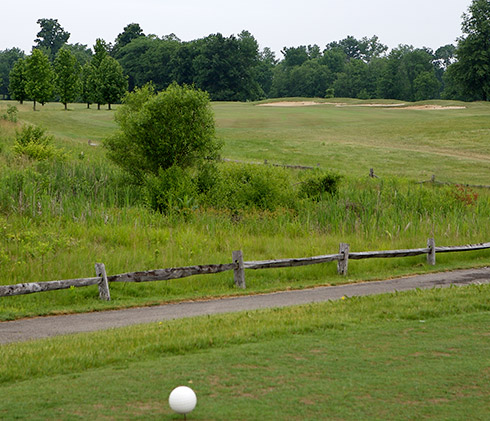
The 17th tee: the ideal line actually carries the trees (and that bush) on the left, unless you really hit a slinging draw.
The 17th, measuring 549 yards, is also reachable as the tee shot plays downhill. The fairway on this hole begins well off the angle of your drive, which actually plays over some small trees and shrubs. Bite off as much as you can chew, then have a go at the smallish, sloping green. Aside from some bunkers to catch the “chicken” drives right of the fairway, the hole is rather unremarkable once you’re off the tee (and over the trees).
As with any course, the meat of Darby Creek can be found in the par fours. The course gets off to a slow start in this regard, with the first and second holes playing rather blandly as short doglegs right (though the second stretches to 423 from the Championship tees). The fifth plays slightly downhill and 359 yards, but accuracy is favored over length here as two well-positioned fairway bunkers will make the errant golfer pay. This hole, like virtually all the holes at Darby Creek, seems to have been laid upon the land rather than forced upon it. Even mounding that was no doubt artificially created seems more “discovered” or “utilized” rather than “built.”
The Links side closes with two virtually 90° doglegs. The eighth, at 434 yards, bends right over a pond. Carry the water and you’ll have nothing more than a 9-iron or pitching wedge in; play left and you could have a 4-iron in from the middle of the fairway. The hole manages to pull off the gimmick of a 90° hole without seeming gimmicky for an instant.
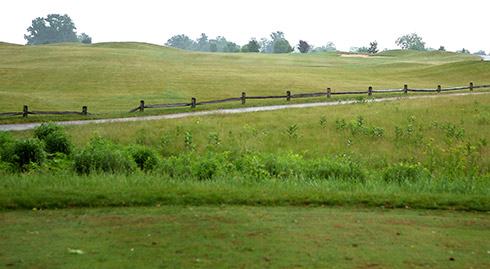
The fourth, a par five, features perhaps the most boring tee shot on the course. Just hit it over the hill.
Unlike the eighth, where the entire landing area is visible from the tee, the ninth obscures the landing area with high fescue and mounds. The 460-yard hole doglegs left and provides a very confusing look from the tee. My foursome had no idea what line to take or how far we had to carry the ball because, despite being downhill, we couldn’t see the landing area. A fairway bunker on the right side seems like an ideal aiming line, but two drives that were be duck-hooked ended up in the middle of the fairway, 40 yards ahead of the fairway bunker. I suppose you would know where to aim the ball after playing the hole four or five times, but it still leaves a sour taste in my mouth. I’m okay with an architect trying to confuse me, but not when they do so by obscuring. I’d rather they try to confuse me with seemingly conflicting information, not by a dearth of information.
The back side begins with one of my favorite holes at Darby Creek – a par four measuring only 335 or 309 yards. It’s heavily bunkered, including in the driving area (180-220 yards from the tee), and features a heavily slanted green. Despite its length, attempting to drive the green is likely not an option, but playing it with a pair of irons is no bargain either. Par is still a good score here.
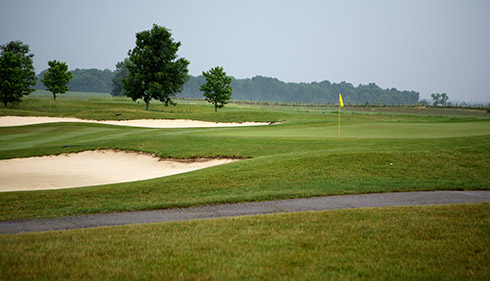
The green at the par-five fourth, fortunately, is more interesting than the drive.
The 12th hole is the first hole on the “Woods” side that really has any trees. They line both sides of the hole, and a pond fronts the green. Chipping areas exist behind and to the right for those too cowardly to challenge a pin tucked behind the water on the left, and the hole features great driving lines regardless of whether you play a draw or a cut. Ideally, of course, you’ll want to be right to avoid as much of the water as possible, but the right side of the fairway is made risky by a single fairway bunker. The hole plays a lot like a Donald Ross – provide a wide fairway with good lines, but put trouble close to the ideal line into the green. If the player chickens out, give them options with chipping areas and a crowned green with false edges.
Unfortunately, the 13th and 15th fail to measure up to the high standards set by the 10th and 12th. They’re strong holes, the former of which is likely to leave an approach from a downhill, slanted lie, and the latter of which played a part in one of my crispest shots ever (from the fairway bunker on the right), but they’re straight-away and lack the intricacy of the first pair of two-shot holes on the back nine.
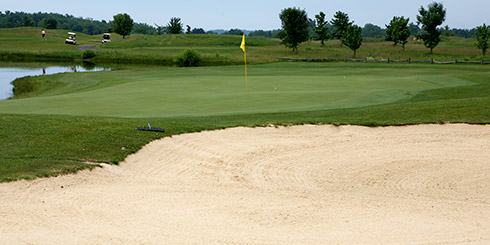
Looking back at the 11th green from behind. Don’t go long, or you’ve got a bunker shot with water on the other side.
The 18th again returns to a more “Links” feel than the “Woods” nine deserves, but it does so at 475 (or 452) yards. The second shot plays over a large pond, to a very thin green protected left by a bunker. Again, a bail-out area is provided short and right, but the green slants hard from back to front. It’s needed to hold the long- or mid-iron approaches on the shallow, wide green, but it makes putting all the more difficult. In one round, I slashed a 5-iron from 190 yards out in the left rough to three feet, but had to play a foot of break on my birdie putt. In the tradition of brutal closers, this hole is indeed a beast, yet with the bail-out area remains fair for those who lack the length (or the lie if they mis-hit their tee shot) to reach in two.
Despite the phony separation of the nines into “Links” and “Woods” sets, one theme does run consistently throughout the course: shotmaking. I like to play shots right to left and left to right. I like to change the trajectory of my shots, running some on and flying others to the hole with spin. Darby Creek mixes options (like split fairways, short par fours, hard doglegs with increasingly long carries) with demands: some of the greens are set up for a draw, others for fades. The same is true of tee shots, even on the straight holes, often by the placement of the fairway bunkers or fairway contours.
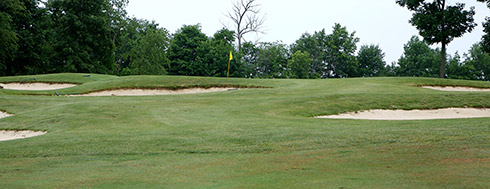
The approach at the reachable, uphill par-five 14th is fraught with peril and two very large bunkers.
I’ve always found that a good blend of the two – options and demands – creates for the best golf, and perhaps the greatest accomplishment of Cornish and Silva was the subtle blend of the two found at Darby Creek.
Bang for the Buck
Darby Creek offers a number of prices. If you are an early golfer (before 10 am) or a twilight golfer (after 2 pm), you can get out for $22 walking or $33 with a cart. Juniors can play for $18/$29 and seniors for $19/$28. If you’re just looking to play in the middle of the day during your middle ages, you’ll pay $29/$38 or $25/$36. On weekends and holidays, the rates jump to $39 and $48.
If you can justify the drive into the middle of nowhere (I can’t imagine many people live within 20 miles of the joint), Darby Creek is well worth the cost of admission, even on weekends.
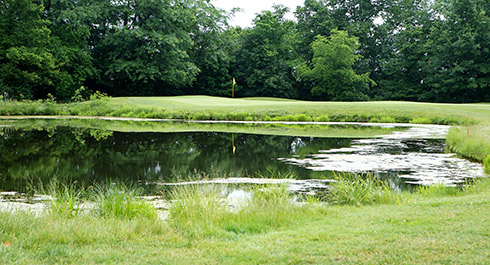
The twelfth green is protected by a pond. The ideal approach angle – from the right – is guarded by a fairway bunker. Classic!
Conclusion
Darby Creek is a joy to play for golfers of any skill level. Higher handicappers will appreciate the bail-out areas, rather open fairways (even on the “Woods” side), and relative scarcity of greenside trouble (if they can avoid the side of the green that’s bunkered). Better players will appreciate the demands placed on their game and the options given to them, the smooth putting surfaces, and the variety of shots required to play well.
Aside from some complaints about a little grassy hardpan and the silliness of naming the nines the “Links” and “Woods” side, I recommend Darby Creek to anyone looking for a new course in the Columbus area.
Scorecard
Hole 1 2 3 4 5 6 7 8 9 Out Par 4 4 3 5 4 5 3 4 4 36 Champ 369 423 189 558 359 520 172 434 460 3484 Back 350 374 169 529 339 486 144 418 438 3247 Hdcp 12 6 8 14 18 16 10 2 4
Hole 10 11 12 13 14 15 16 17 18 In Par 4 3 4 4 5 4 3 5 4 36 Champ 335 194 426 462 502 436 211 549 475 3597 Back 309 168 411 435 492 419 188 540 452 3414 Hdcp 14 16 12 18 4 8 10 6 2
Totals Champ 73.7 129 7,074 yards Back 71.3 124 6,661 yards Middle 69.3 119 6,201 yards Forward 69.3 118 5,942 yards
First of all, another excellent review, Erik! Overall, I think your assessment of Darby Creek is right on. However, judging by the pictures it looks like you played on a low or no wind day. Seldom is that the case at Darby and course is definitely set up to use the prevailing winds as part of its defense. I’ve played in a league there for the last eight years, and it almost always seems to be blowing out there.
For instance, you felt the front 9 par 5s were not very reachable, while 14 and 17 are. While #14 is hybrid/hybrid for me, I’ve only reached 17 in 2 a time or two (and I’m not exactly short off the tee). It usually plays into the prevailing wind, and the uphill slant to the green and the front bunker tend to stop anything from running up.
In contrast, #4 and #6 generally play with at least a little helping wind. In fact, when there’s a strong south wind, #4 is often only a long iron second shot. And a strong west wind makes #6 pretty easy to get to. Carry a drive to the top of the fairway ridge by the first two bunkers and you can find yourself with as little as 150 in when the ball finally stops rolling. As you pointed out, the fairways do get firm!
The same wind influences the shorter holes. #2 plays a little longer than its yardage, but even average length players can clear the fairway bunkers from all tees but the very tips. But the hole does mount a formidable defense at the end. Talk about the importance of keeping the ball below the hole. The front pin on #2 is the toughest pin on the course, and I’ve seen several people putt off the green there (the front position on #10 is almost as severe). Tap a four footer from pin high and the ball will roll 8-10 feet below the hole if it doesn’t go in.
Saying that the water on 11 doesn’t (or even shouldn’t) come into play is a little far fetched. The wind almost always seems to be blowing left to right into the player’s face here, which naturally tries to push every shot into the water. The front pin is easy, but that’s the only one. Overdo or hit short with a fade, and you can hit land or even the green and still get wet. And if you play long and safe behind the green, the slope brings the pond in play on your chip.
On #13, the chute out of the trees gives a lot of players fits. It’s the one hole on the “Woods” side where you can hit a fairly decent drive and still clip a tree. Everywhere else, the ball has to go a ways offline to find the woods. (As Erik points out, the Links and Woods are really pretty similar in design, there’s just more shade on the back nine.)
Erik’s dead on about #9. I think it’s the real only gimmick hole on the course. Along with #15, it’s probably my least favorite. A 3-wood at the 150 post is probably the safest play, though you may still go through the fairway. Every other angle has potential for a really big number. You can blast a driver well left and wind up with 100 yards in, but you’ll be holding your breath until you get out there and see. You just never know on that line.
Darby is just an overall fun course to play. It’s kept in good shape. There are no “throw away” holes, though I’d like to throw away #9 from time to time. They can all be your friend one day and bite you the next. The holes that most keep me coming back are #5, 6, 10, 12, 14, and 18, but the remainder are strong as well.
I played there twice, actually, and both days had only a little breeze. At most, a one-club wind.
I’ll respond to some of your comments here publicly, but if I don’t go into enough depth or you have more to say, feel free to email me privately to continue or expand the conversation.
I cut up the left side both times. The first time, I reached it with a three-wood. The second time, I laid up with a 5-iron and had 55 yards to the pin. But again, you’re right, little wind those days.
I think there’s a pretty generous landing area to the left. I admit to sometimes forgetting that almost everyone slices like crazy, too, but even considering that, and the wind you mention, I still don’t believe it should come into play unless you really want to go after a back-right pin.
I’m glad you agree with my assessment. It’s tough, as you can imagine, playing a course a few times only before writing a review, and especially so when the weather isn’t normal. I’m glad you could stop by to offer a more seasoned opinion. Thanks.
When the pin is back right on #11, that is a pretty tough hole.